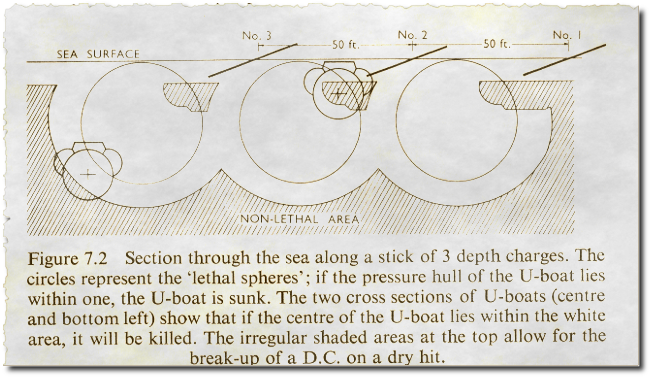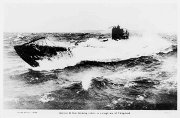Choosing the Depth
At the start of the war a D.C. was normally set to explode at 100ft or 150ft below the water. This was calculated by looking at how long a U-boat has to submerge from when it sees the aircraft to when the D.C. will explode. The depth the U-boat can submerge to in this time was taken as the required depth setting of the D.C. This view was however challenged by the O.R.S. They argued that if a U-boat has time to fully submerge then its position becomes less well known making aiming difficult. If however it does not have time to submerge fully or chooses not to then its position is known however the D.C. will explode far below the surface and not do sufficient damage. This meant that U-boats were not really being effectively targeted at any depth.
One of the main properties of a D.C. is its lethal radius. This can be thought of as a sphere around the centre of the explosion. If the hull of the U-boat lies within this sphere it will be sunk. For a 250lb D.C. this was believed to be around 19ft. There is also a larger sphere known as the damaging radius within which the U-boat will only be damaged. In reality these were more like areas of probability where the U-boat was likely to be sunk or damaged. The Admiralty were keen to increase this radius by using better explosives or heaver bombs. They argued that since the area of the spheres increases as the cube of the radius the probability of the U-boat being in the sphere also increased as the cube of the radius. They also believed that the power of the explosion fell off linearly giving less well defined boundaries and a large damaging radius. This also meant that improvements in the power of the explosion would give good improvements to the lethal radius. The O.R.S. however found the power fall off was closer to a squared relationship. This made it more difficult to increase the lethal radius meaning changes to depth settings or stick spacing might be more effective.

One possible solution to this was to increase the explosive power of the D.C. This would increase so called lethal radius for the explosion which is to say the distance from the explosion within which the U-boat will be destroyed. If this distance was increased sufficiently then a D.C. exploding at 100ft would still destroy a U-boat on the surface. It was however found that such an increase was not practical. The alternative approach proposed was that it would be better to reduce the depth setting.
The argument was that due to problems locating U-boats which were deeply submerged they were very difficult targets. Therefore greater returns could be gained by targeting U-boats which were on the surface or recently submerged at the moment of attack. This still represented around 40% of U-boat sightings. This argument was accepted by the admiralty and the depth was initially reduced to 50ft by the end of 1941. The O.R.S. still believed this was too deep especially as with the errors in fuses the actual depth could be around 65ft. The setting was eventually reduced to 25ft in the summer of 1942. This change was also accompanied by a rise in the effectiveness of attacks with 7% of attacks in the second half of 1942 resulting in a sinking.

